20+ SAMPLE Client Intake
-
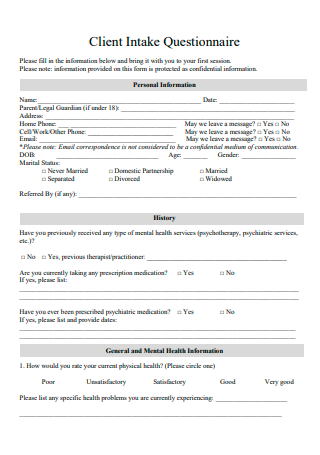
Client Intake Questionnaire
download now -

Business Information Client Intake Form
download now -
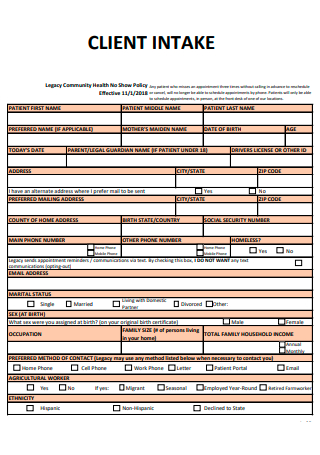
Client Intake Example
download now -
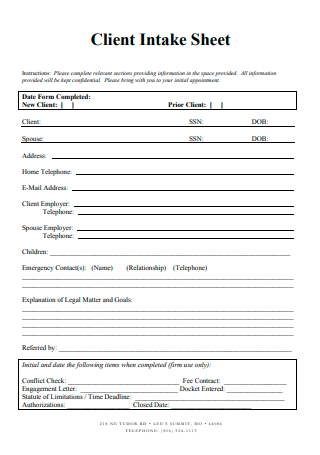
Client Intake Sheet
download now -
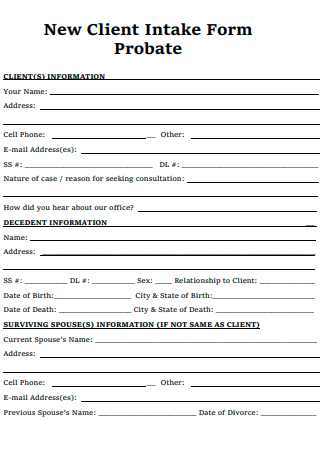
New Client Intake Form Probate
download now -
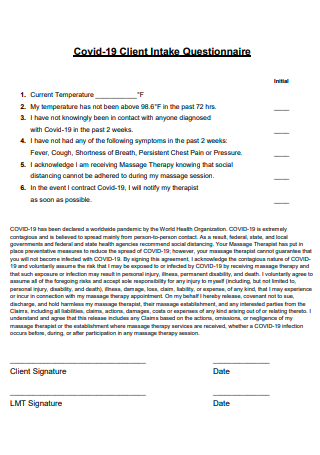
Covid-19 Client Intake Questionnaire
download now -

Client Intake Form
download now -
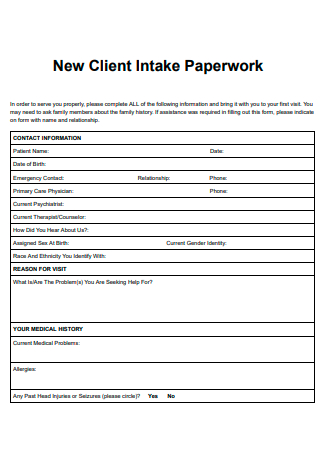
New Client Intake Paperwork
download now -

Adult Client Intake
download now -
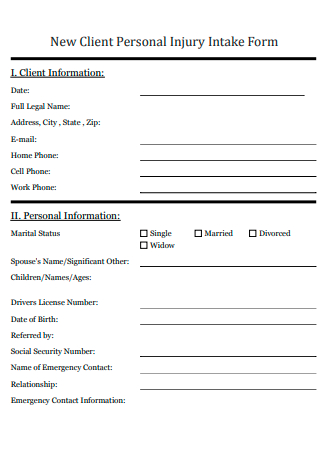
New Client Personal Injury Intake Form
download now -
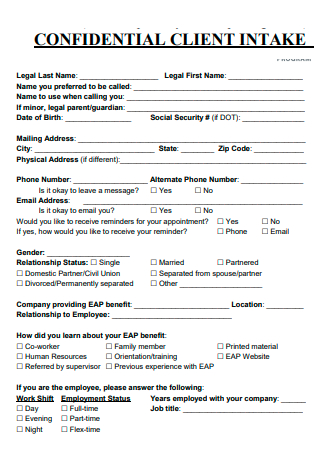
Confidential Client Intake
download now -
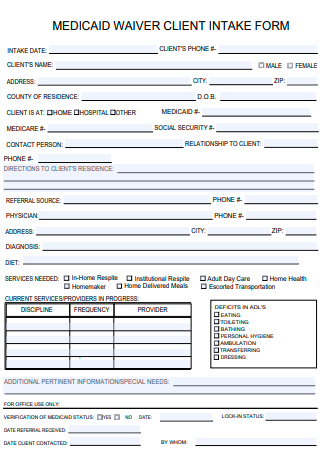
Waiver Client Intake Form
download now -

Client Intake Form For Criminal Cases
download now -
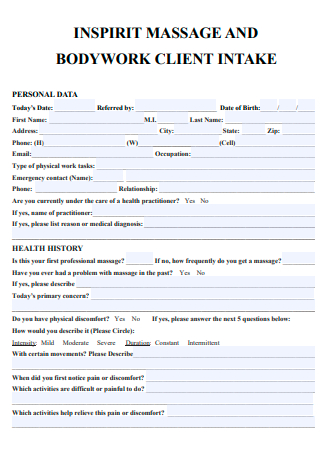
Inspirit Massage and Bodywork Client Intake
download now -

Yoga Client Intake Form
download now -
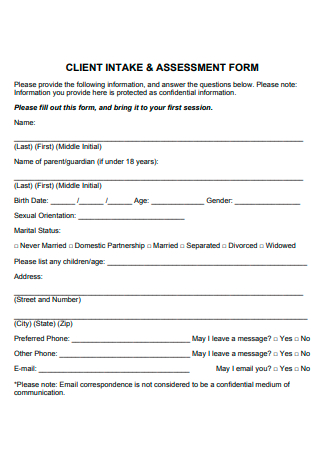
Client Intake and Assessment Form
download now -

Marital Dissolution Client Intake Form
download now -

Massage Client Intake Form
download now -
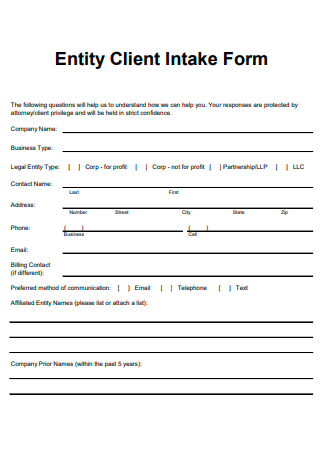
Entity Client Intake Form
download now -
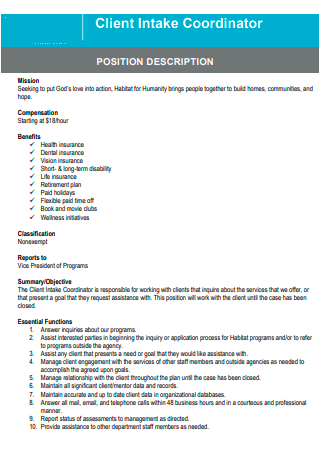
Client Intake Coordinator
download now -
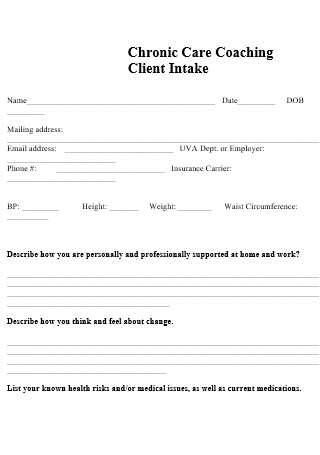
Client Intake in DOC
download now
What Is a Client Intake?
A client intake is a business process that allows organizations to introduce a client to the business and acquire all the information that the business needs about the client to make a project successful. It is the chance for the company to ask questions to their clients for a smooth transition into the business. Different businesses have different types of client intake processes for new clients. The process is a necessary follow-up on the successful marketing campaign that the business or a representative conducts for the client. Many companies exhaust time, energy, and money when implementing marketing strategies and campaigns for customers. As such, they must ensure that clients react positively to it. The client intake process involves all the steps that an organization takes to greet and evaluate the individuals who make the initial contact with the business. Different companies react differently to initial contact with the presence of laid-back companies, while others make it a priority to make a lasting impression. The intake process must be considerate of the time of the client while gathering the necessary information and evaluating their needs, making it a vital business capability. Focusing on good customer service encourages client referrals and customer loyalty.
According to the 2017 State of Global Customer Service Report coming from Microsoft, an average of 98 percent of customers or clients say that the customer service of a company contributes to their loyalty to a brand. As such, companies must take the time to build on their first impressions and maintain their quality of customer service, not only to attract but to retain clients.
Parts of a Client Intake Form
The client intake process requires companies to acquire the most relevant information from new clients they onboard. As such, the companies taking in clients are responsible for setting up a document where they can ask the necessary questions to gain a better understanding of newer clients and acquire the essential information. Client intake forms are useful for screening new clients. Make sure to make the questions in the client form concise and straightforward. Take the time to classify what kinds of answers the company is expecting, whether they are long forms, yes or no questions, or multiple choice. Effective client intake forms acquire the necessary information to provide the best solutions to clients. The section below covers the different parts of a client intake form that the organization can use for the client intake process.
How To Build an Effective Client Intake Process
The client intake process is not always smooth, and clients are not always a good match for the agencies that want to accommodate them. If a firm or agency does not have a client intake process in place, they are losing a lot of time working on administrative and organizational activities. The section below covers an effective intake process that your organization can implement to ensure that you are onboarding the right clients.
Step 1: Manage Calls Professionally and Intelligently
Equipe yourself with a professional contact number or a work phone when making and answering calls from potential new clients. Privacy is of utmost importance, and there is software that agencies can utilize, providing them with a personal number that allows an organization to track calls and text messages that automatically convert into billable events. After having a private work number, establish professional greetings and a menu. Consider blocking spam calls as well. Remember that PNCs (probable new clients) have no boundaries when it comes to time constraints, making sure that the company line routes correctly during holidays, vacations, and schedule adjustments whenever no one is available to answer calls directly. Track performance and essential information the agency needs to calculate for advertising and marketing dollars. To increase non-referral leads, the agency must focus on target demographics and geographic locations. Track the positives and negatives of the whole onboarding process.
Step 2: Automate the Lead Capture and Qualification Process
Start the next step by formulating selection criteria for the PNCs. The agency must be specific about what they want and avoid. All of the factors and instances must reflect on the criteria or be present in the client intake questionnaire to screen PNCs. During the initial meeting, set the consultation policy. Determine the different consultation methods they can avail of, the duration for each consultation, and the price of consultations. Make sure to use and maximize the time with clients by automating repetitive and monotonous tasks. Set up effective workflows to ensure that data collection goes smoothly, making tracking easier for the agency.
Step 3: New Client Intake
After capturing leads, begin the process of completing the client intake process. Start by asking how the client has come to know the agency. The intake process takes time, and different firms engage in the client intake process before or after the initial meeting. Identify all the necessary questions for a standardized process, coming up with five to ten questions to make it more manageable for clients to supply the necessary information in the form. The agency can utilize software that can assist them with completing client intake forms for efficiency and professionality.
Step 4: Streamline Appointments
The most efficient and effective method to book appointments is to have a booking page on the company website. Ensure that the information a client inputs on the page directly transmits to the agency calendar and guarantee that the client submits their appointment time and immediately receives instructions for the following steps to take. As in step 2, indicate whether there are consultation fees a client needs to shoulder.
Step 5: Differentiate Good Leads from Bad Leads
After generating a list of clients, separate those that are not a good fit for the agency. As such, the firm must have conditions and methods after generating bad leads. Refer to the selection criteria and use them to identify unqualified leads to save time. Communicate with the legal team of the firm and share the list of unqualified clients with the staff, including the necessary instructions to identify the appropriate firm that can assist them, according to location, area of expertise, and cost equations.
Step 6: Record As Much Information As Possible
Integrate as many of the communication records into the software system as possible. Texts and calls must have call logs with consultation notes and records. Activity logs must also have documentation, and all essential workflow must have the necessary action plan for the intake process. Utilize project and documentation tools to integrate emails and documents into the system seamlessly. It saves time and reduces human error.
FAQs
What should be on a client intake?
A client intake must consist of essential knowledge about a client, including their contact and company information, what they do or produce, current challenges, client goals, budget plan, competitor analysis, and other related questions.
What is the intake process?
The intake process refers to the comprehensive and well-defined process and foundation of the ongoing relationship between a client and a vendor towards collecting vital information about a client and the project that the company uses to track and monitor the project lifecycle.
What does it mean to perform an intake process?
The intake process is a critical step for organizations in making an initial appointment or meeting with clients to gather all the necessary information about the client and their background while they learn about the services the company or agency provides in exchange.
Forming harmonious relationships between a client and a vendor is one way to ensure that a business or organization continues to grow and develop towards its goals and aspirations. As such, an initial assessment or appointment with a potential client helps a company understand the client’s goals and objectives, making it more manageable for the vendor to provide the most beneficial and cost-effective solution or service. Craft a client intake form that the company uses to perform the client intake process and evaluation to achieve both parties’ objectives, selecting from the wide range of ready-use and editable templates from Sample.net.
